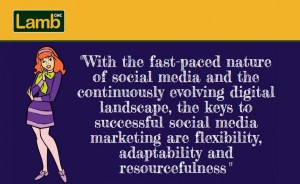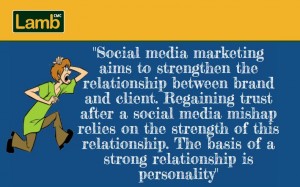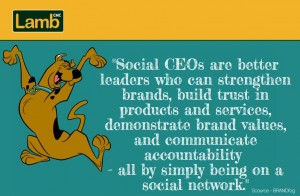As Social Media Week comes to a close, it's clear that more companies than ever are paying considerable attention to their social media strategies. Particularly in the B2B space, concerns range from social being exclusively for younger generations to theories that a presence could provoke negativity rather than positivity, and nervousness surrounds the early adoption of creative approaches. This means producing an effective social media strategy is not always straight-forward.
Earlier in the week, we referenced The OC in a post about the importance of using social channels to protect your brand's reputation and to nurture relationships with ambassadors. Now we're merging a childhood passion, Scooby-Doo, with our grown-up passion of social media marketing.
Before considering reputation management and relationship nurturing techniques, tone of voice and an overall social media strategy must be agreed upon. Due to the new and creative nature of social, the options are endless and a variety of social media action plans are constantly being created, some successful and others less so.
But what makes a social media strategy work? According to Social Media Examiner, the burning question for the vast majority (91%) of marketers is, “What social tactics work best?” Some of the most common ones can be personified via the gang of Mystery Inc:
What do Scooby-Doo characters know about social media?
Velma - monitoring and measuring
Velma is a highly-intelligent young woman with various obscure interests, ranging from sophisticated sciences to ancient Viking writing. Consequently, Velma is usually the brains behind figuring out the mystery, with the (often unintentional) help of the others.

Velma represents a pragmatic and structured social media marketing strategy. She would analyse each platform and her competitors' activity, create an editorial calendar for what and when each piece of content will be; produce detailed reporting to measure performance and provide a basis for future strategies. Her geeky nature would ensure every post has a purpose, entering her into the elite 37% of marketers who can measure their social activity by conducting it correctly.
Taking a structured and logical approach to a social strategy is important. Knowing why, when and how to implement your activity is vital, as is confidence in knowing who to target and how to measure success. However, like Velma, this academic and regimented approach will only get you so far in solving the mystery of social media...
Daphne - flexibility, adaptability, resourcefulness
Daphne is the enthusiastic one, always following her intuition and surprising the rest of the gang with her development from damsel in distress to a stronger and more independent, self-defence heroine. She occasionally helps the others capture villains by using some random accessories in her purse.

What does this teach us about our social media strategies? That the ability to be resourceful with the tools you possess, to adapt to events occurring around you, and to constantly build on areas in which you can improve are all key to success with the fast-paced, public nature of social media where activity should be timely, accurate and innovative.
These elements, together with a passion and enthusiasm for the social media journey you are embarking on, are a great basis for rich content generation as well as the frequency and tone of posts. However, these alone would make for a weak and structureless plan, with the included risk or irrelevancy and mistargeting.
Fred - focusing on followers and current trends
Fred is a loveable character, despite his aura of vanity and self-involvement. He is often seen taking the lead on solving mysteries.
Obsessed with his image, Fred's Instagram and Facebook would be full of selfies with hashtags - we imagine #FitFreddie would feature heavily - and his Twitter feed would be an abundance of Tweets about himself. He would be the first to jump on bandwagons of trends such as the #ALSIceBucketChallenge and, being the popular guy he is, would be constantly focused on engaging with and growing his follower base.

While posting about yourself 100% of the time is a no-no, Freddie-style posts are a valuable addition to a company's social activity. Businesses are, at the end of the day, using social platforms to promote themselves. Direct self-promotion should be limited, but we recommend showing off your brand and services in around one third of your posts. Images and videos enhance the engagement with a post. Twitter research shows that videos boost Retweets by 28% and photos generate a 35% increase.
Freddie would be fixated on his quantity of followers, but in the B2B sphere we recommend switching this focus to quality, with the objective to attract relevant followers. Using current trends is also a great way to maximise the benefits from social channels while exhibiting your brand's personality, but only when you can make it relevant to your business and your target market.
So, while it should be toned down, Freddie's social media strategy is also an integral component to the overall approach.
Shaggy - adding personality and not being consumed by the fear of potential mistakes

Ridiculed by the others for being 'useless', Shaggy always attempts to solve mysteries in his own, amusingly unique ways. While there is usually some sort of disaster along the way, Shaggy's methods often somehow lead to a successful diagnosis.
From Shaggy, we learn that it's okay to try out new methods and let your personality shine through to set you apart from your competitors. In B2B sectors, the content available will not always be the most exciting. The challenge is to find your own, individual ways for your brand to present this content in a way that stands out and sparks engagement.
In social media as well as in Scooby-Doo, mistakes are sometimes made. While this can be unnerving, the worst that can happen is you will provide yourself with an opportunity to gain respect through your recovery, just as Greggs did in the recent Google search information issue. Contrastingly, when Shaggy messes up, he's potentially letting a terrifying ghost loose to haunt innocent victims, so repercussions of mistakes could always be worse than yours!
Scooby - utilising your main character/asset
Scooby-Doo is, of course, the main protagonist. Scooby-Doo is a unique dog who is able to speak English. In a potentially controversial analogy, we pronounce that Scooby is similar to the CEO of a company (a comparison we're sure Hanna-Barbera never thought they'd hear).

Scooby is the centrepiece of the group, but when it comes to the crucial moment of solving a mystery, or adopting a social media strategy, he becomes afraid. Nervous and unsure of what to do in this uncomfortable situation, he looks to the others for guidance (and Scooby Snacks).
While the team could easily solve crimes without Scooby, the result would be nowhere near the same. Scooby provides entertainment, as well as the occasional, albeit accidental, valuable insight. This translates to corporate social media strategy too. Sure, your company could develop and deploy a strategy without input from your senior people, but would it lack vital pieces of content and insights? Yes. Would it miss valuable opportunities to be seen by important and relevant people in the market? Definitely.
No doubt some are highly tech-savvy, but many of those in senior roles are often wary at the first mention of social media. Only 28% of Fortune 500 company CEOs are on LinkedIn, 7% on Facebook and 5.6% on Twitter. By ignoring social media, CEOs risk missing out on important conversations, crisis management opportunities and the opportunity to extend their brand's reach to their extensive network of valuable and relevant contacts.
One of the tasks we regularly find ourselves addressing is how to get buy-in from senior staff or unsure employees. We offer companies a 'Scooby Snack' in the form of social media introduction and training sessions, using our expertise and experience to reassure them along the way.
All aboard the Mystery Machine!
 Each of these characters individually represents great social media strategy qualities but, in order to optimise the effectiveness of a strategy, a combination of all of the above should be included in your plan.
Each of these characters individually represents great social media strategy qualities but, in order to optimise the effectiveness of a strategy, a combination of all of the above should be included in your plan.
First, you must accept that mistakes and negativity can occur. However, this can happen whether you choose to have a presence or not. Being present, actively listening, and knowing how to respond will give you the power to quickly turn any problem into a positive.
Reflecting your brand's unique personality with carefully-planned content and analysis of performance is a must, along with the application of popular trends to communicate your message, utilisation of available tools, news and ideas, and input from senior levels.
Applying a balance of Velma, Daphne, Fred, Shaggy and Scooby into your plan will form the perfect, integrated mix of the necessary components of a successful social media marketing strategy.
So with the help of these meddling kids, for once, you just might get away with it...
For our advice on how to be more like the gang, get in touch: info@lambinthecity.com or Tweet us @Lambinthecity
SCOOBY-DOO and all related characters and elements are trademarks of © Hanna-Barbera
